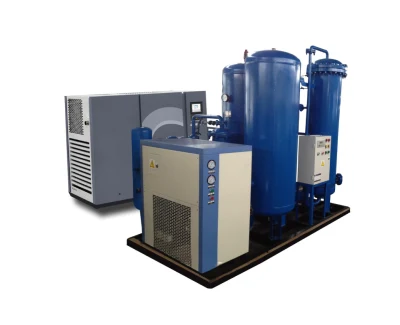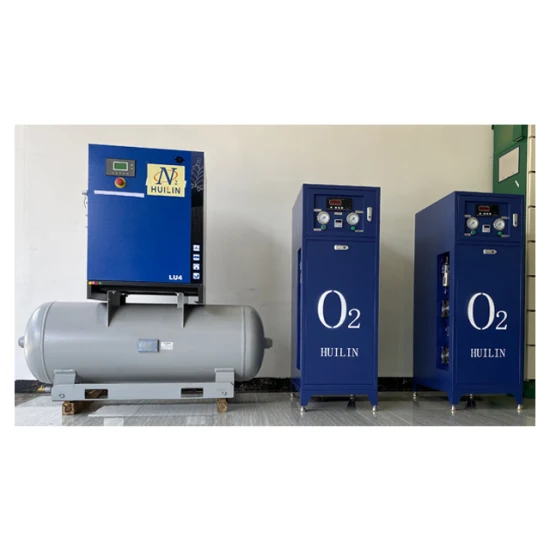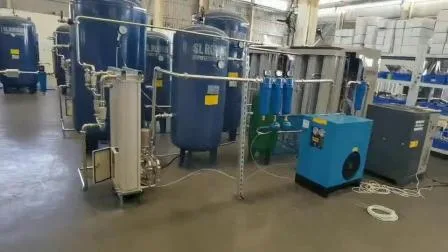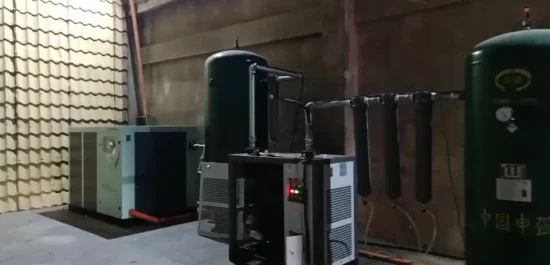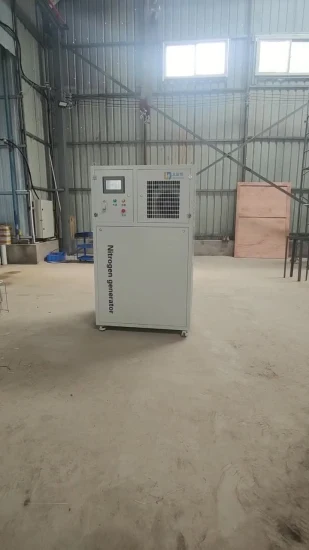
Lo3-40 Sterilizzatore generatore di ozono Generatore di azoto alimentare da 40 g
Descrizione
Informazioni di base
| Condizione | Nuovo |
| Certificazione | RoHS, UR, ISO, CE, CCC |
| Voltaggio | 380 V |
| Garanzia | 1 anno |
| Tip | Montato/containerizzato su skid |
| purezza | 99-99,999% |
| Componenti principali | PLC, recipiente a pressione, elettrovalvola, molecolare |
| Assistenza clienti | Gli ingegneri sono disponibili per la manutenzione delle macchine all'estero, |
| Punto di rugiada dell'azoto | -40°C |
| durata | dieci anni |
| Pacchetto di trasporto | Esportazione di scatole/pallet di legno standard |
| specifica | 1000*1200*1500 |
| marchio | LDH |
| Origine | Pechino, Cina |
| Codice HS | 841960 |
| Capacità produttiva | 500 |
Descrizione del prodotto
Imballaggio alimentare da 40 m3/h, macchina speciale per azoto, purezza 99,99% LDH GAS Systems è un produttore cinese specializzato in impianti di gas in loco per la produzione di azoto, produzione di ossigeno, sistemi di purificazione, ecc. Sistema compatto per azoto ad elevata purezza su montaggio su skid. Dal 2017 sono stati costruiti più di 100 sistemi in tutto il mondo e stanno conquistando il rispetto di tutti grazie alla loro affidabilità, convenienza, praticità e ai nostri eccellenti servizi. Una famiglia di sistemi LDH viene utilizzata in diversi settori: chimico e di raffinazione, produzione di petrolio e gas, elettronico, aeronautico e aerospaziale, farmaceutico/sanitario, alimentare, metallurgico, del vetro, dell'estrazione del carbone e dell'acquacoltura. I sistemi LDH sono l'incarnazione della sintesi tra tecnologia all'avanguardia e tecniche di produzione perfette. Il nostro obiettivo è fornire ai nostri clienti sistemi di separazione dell'aria LDH più affidabili, economici e convenienti e servizi più professionali. Nome completo del generatore di azoto PSA: Pressure Swing Adsorption (PSA). PSA è una nuova tecnologia di separazione dei gas che si è sviluppata rapidamente all’estero a partire dagli anni ’60 e all’inizio degli anni ’70. Il suo principio è quello di separare la miscela di gas mediante setacci molecolari in base alle diverse “prestazioni di adsorbimento” delle diverse molecole di gas. Come materia prima viene utilizzata l'aria. L'azoto e l'ossigeno nell'aria vengono separati mediante adsorbimento selettivo di azoto e ossigeno con alta efficienza e un'ampia gamma di adsorbenti solidi.
Attualmente, i setacci molecolari del carbonio e i setacci molecolari della zeolite sono più comunemente utilizzati nella produzione di azoto e ossigeno. La separazione dell'ossigeno e dell'azoto mediante setacci molecolari si basa principalmente sulle diverse velocità di diffusione dei due gas sulla superficie del setaccio molecolare. Il setaccio molecolare del carbonio è un adsorbente a base di carbonio con alcune proprietà del carbone attivo e del setaccio molecolare. I setacci molecolari del carbonio sono costituiti da micropori molto piccoli con dimensioni dei pori comprese tra 0,3 nm e 1 nm. Il diametro più piccolo del gas (ossigeno) si diffonde più rapidamente e maggiormente nella fase solida del setaccio molecolare, in modo che l'arricchimento di azoto nel setaccio molecolare è possibile ottenere la fase gassosa. Dopo un certo tempo, il setaccio molecolare con adsorbimento di ossigeno si equilibra, corrispondente al setaccio molecolare di carbonio sotto pressione diversa nell'adsorbimento di diversi gas Caratteristiche di adsorbimento: ridurre la pressione per rimuovere il setaccio molecolare di carbonio nell'adsorbimento di ossigeno. Questo processo è chiamato rigenerazione. PSA utilizza tipicamente due torri in parallelo, alternando adsorbimento pressurizzato e rigenerazione con decompressione per ottenere un flusso continuo di azoto.
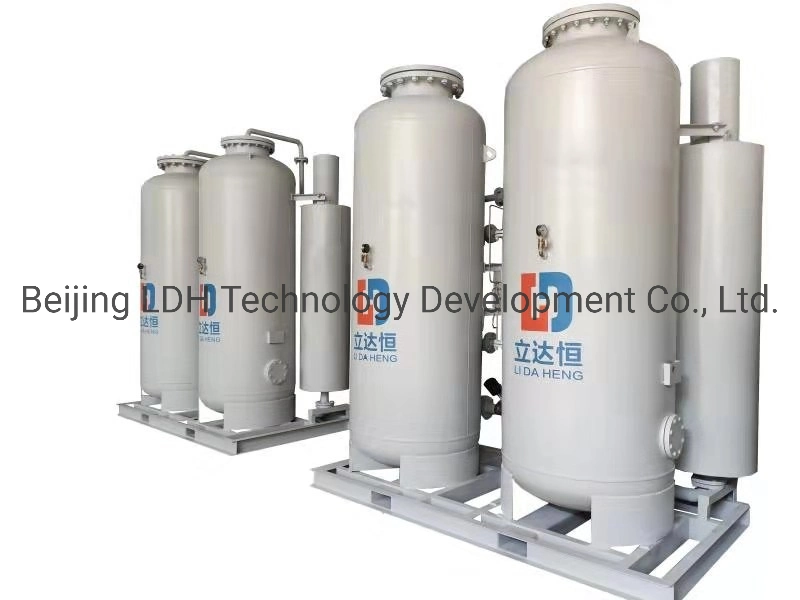
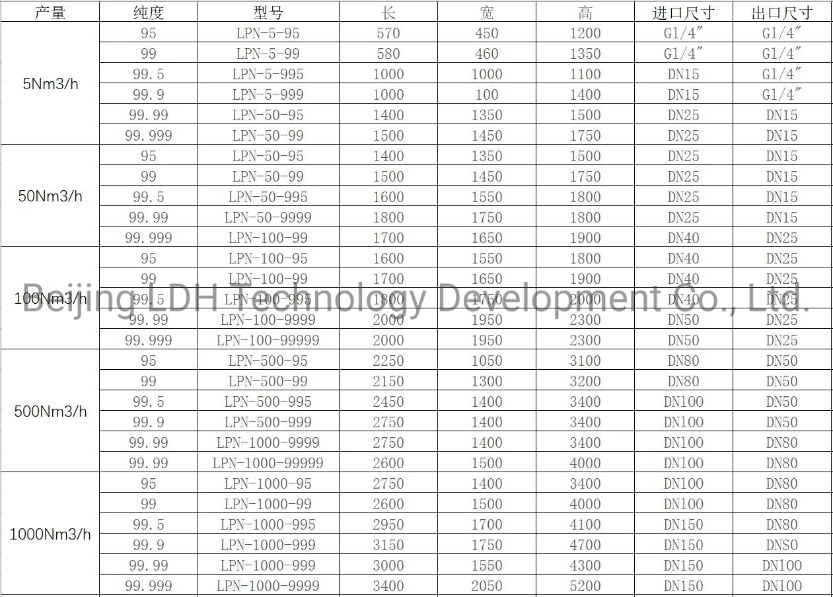
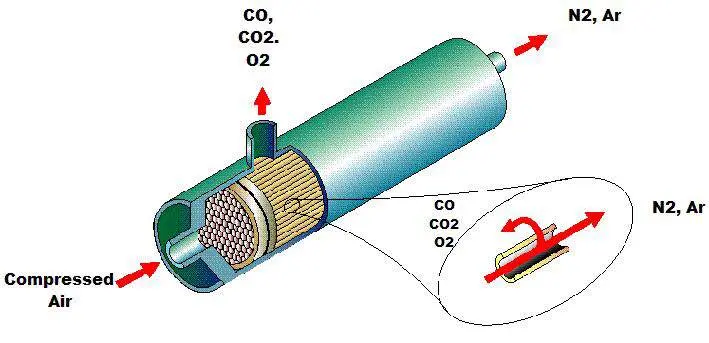
3) Spare Parts ServiceWorldwide, quick and low-priced over the complete lifetime of your plant. The distinct tagging of all plant components delivered by us enables us to identify clearly the spare parts requested by you. We supply you with products designed for a long life and economic efficiency. For modifications and extensions we look for the most optimal and economic solution for your individual purpose. 4) Maintenance/RevisionsRegular inspection and maintenance ensures permanent operation, avoids damage and prevents unexpected breakdowns. In the course of maintenance/revision works we check all relevant components for function and condition, exchange defect, used and worn parts and afterwards optimally eadjust your plant to the given operating conditions. Depending on the plant size and scope of work, our service range comprises also a detailed scheduling of revisions as well as coordination and supervision of contractors. As a matter of course we supply maintenance documentation in form of reports and spare part recommendations, and we coordinate our schedules according to your requirements. 5) TrainingKnow-how for your personnel. Operation, maintenance and repair, electric measuring and control equipment or process engineering - we offer you specific training by our experts. Whether on site working with theplant itself, or on our permises, we concentrate on your questions and problems. What is a Packaging Gas?Air contains approximately 78% nitrogen, 21% oxygen and a variable amount of moisture. When exposed to air, foods such as potato chips absorb moisture and go stale and soggy quickly. Atmospheric oxygen also reacts with the unsaturated fatty acids present in foods, resulting in rancid off-flavours. Consequently, it is always a challenge faced by food manufacturers in preserving the desirable quality and prolonging the shelf life of food products.The use of packaging gas is an effective solution. A packaging gas is a gas that is introduced into a package before, during or after filling with food to protect the food from oxidation or spoilage. Examples include nitrogen, carbon dioxide and nitrous oxide. Nitrogen has a long history of use as a packaging gas in various foods including snacks, breakfast cereals, candies, bakery products, dried fruits and vegetables, and processed meat products.Nitrogen Does More than a Packaging GasNitrogen has found its way to the brewery and coffee industries where nitrogen is infused in beer or cold brew coffee to make 'nitro beer' or 'nitro brew', giving the final product a richer and creamier mouthfeel.How does Nitrogen Work as a Packaging Gas?Unlike the air you breathe every second, nitrogen used in food packaging contains very little oxygen and moisture. Nitrogen is inert (i.e. not reacting with any food components), odourless and tasteless. When nitrogen is introduced into a package, it drives out oxygen and any moisture present. By modifying the atmosphere inside the package, food packaging with nitrogen preserves quality, slows down spoilage and extends the products' shelf life.Nitrogen also cushions and protects delicate foods inside the package from being crushed during handling. Nonetheless, the amount of nitrogen used should provide enough protection but not too much to allow space for additional expansion due to pressure changes in transit and during storage.The package, with low gas permeability, must be sealed tightly to prevent the nitrogen from escaping. Once you open the package, the food inside is exposed to atmospheric air containing oxygen and moisture. Without protection from an immediate, controlled environment, the contents are then prone to moisture pickup, spoilage and oxidation. Therefore, it is best to consume the food products as soon as possible once the package is opened.Food suppliers are always seeking ways to extend shelf life. Improved shelf life allows manufacturers to extend their geographical reach and allows the product to remain in stores and consumer's homes longer. Modified Atmosphere Packaging (MAP) is a technique commonly used in the food processing industry to extend shelf life. The MAP process involves displacing the air inside a package with a protective gas to keep oxygen at controlled levels (less than 2 percent). Too much oxygen and moisture in a package often leads to bacterial growth and oxidation resulting in spoilage, inconsistent flavors, poor product quality, and shortened shelf life. Nitrogen is frequently used as a protective gas because of its dry, inert qualitiesSources of nitrogenNitrogen can be obtained from outside suppliers in the form of high-pressure tanks, dewars, or bulk liquid supply. Nitrogen can also be produced on-site using standard compressed air with an in-house nitrogen generator. An in-house generator separates nitrogen and oxygen from the air, and can often be the most efficient and economical method of supplying nitrogen for MAP applications.Disadvantages of a delivered nitrogen supplyRelying on outside vendors can pose several challenges including uncontrollable price increases, contract negotiations, tank rental fees, adherence to OSHA requirements, hazardous material fees, delivery surcharges, and local and state taxes. Problems such as scheduling conflicts, delivery delays, and lengthy procurement processes can slow down operations.This all adds up to extra administrative work and higher operational costs. The delivery approach also doesn't fit the trend toward lean production techniques and developing fewer, more efficient supply chains. Precautions must also be taken when handling and storing high pressure cylinders. A dangerous situation can be created if a cylinder is dropped and a valve is broken off, potentially causing the cylinder to become a projectile.Operational benefits of generating nitrogen on-siteGenerating your own supply of nitrogen in-house eliminates the challenges associated with outside vendors and ensures long-term cost stability. Generating nitrogen in-house is also good for the environment and represents a sustainable approach to supplying the gas. Producing nitrogen off site at fractional distillation plants and transporting it to end users is energy intensive and can result in large amounts of CO2 emissions.
Indietro: Essiccatore per aria compressa a refrigerazione, raffreddato ad aria
Prossimo: Generatore di ossigeno ad alte prestazioni per il trattamento dell'acqua con ozono
Il nostro contatto


